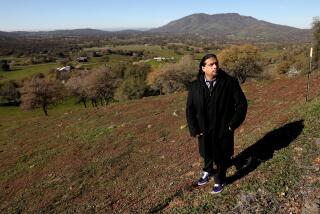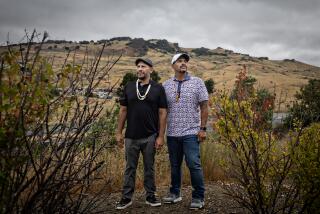Righting History : Juanenos Win State Recognition After 140 Years
- Share via
SAN JUAN CAPISTRANO — After an age-old cry to correct a “mistake of history,” the Juanenos have finally been heard.
About 100 people gathered Tuesday at Mission San Juan Capistrano to celebrate the state’s official recognition of the Juaneno mission band as the original native tribe of Orange County.
With the burning scent of ceremonial California sage in the air, the Juanenos sang, danced and spoke of the struggle that finally led the state Legislature to pass a resolution in September.
“For the state to finally come around after 140 years, that’s just fantastic,” said David Belardes, chairman of the Juaneno tribal council.
It was a “mistake of history,” according to Garnet Birch of the Native American Indian Cultural Center, that caused the Juanenos not to be recognized as the Native Americans who greeted the Spaniards when they arrived to found the mission in 1776.
The center’s DeAnne Tate explained: “In 1850, bureaucrats made a list of all the Indians in the country. By the stroke of a pen, the Juanenos were left out.”
Since then, the Juaneno people, about 3,000 of whom live in California, have battled for acceptance, tribal officials said.
The history of the Juanenos goes back 10,000 years in the arid hills, canyons and beaches of Southern California, according to tribal leaders. At one time, the tribe occupied a coastal area stretching from Huntington Beach on the north, Oceanside on the south, and inland over what is now Cleveland National Forest to Lake Elsinore and Corona.
Juaneno customs, like those of other coastal California tribes, are considered unique. They lived in villages loosely built around a family group, and traveled from one community to the next, from the mountains to the coast, according to Juaneno history.
They subsisted on a rich source of food, from deer to bear--the grizzly once lived in the Santa Ana Mountains--to shellfish in the estuaries and fish from the ocean.
After the Spaniards and Father Junipero Serra arrived, the Juaneno village of Acjachemen at the fork of what is now San Juan and Trabuco creeks became the site for Mission San Juan Capistrano.
Like the Gabrielinos in the San Gabriel Valley and the Luisenos in northern San Diego County, the name Juaneno was given to the natives by the Spaniards who converted them to Christianity in the 18th Century.
Their own religion, Chinigchinich, and language, Acjachemen, were nearly lost amid the Catholicism and Spanish language of the newly arrived colonists.
It was because a few of the elders clung to the customs that the Juaneno ways have been preserved, said George Gollette of Hawaiian Gardens.
“I thank God for those who have worked so hard,” said Gollette, 63. “People like my Aunt Jessie, who worked to get us together.”
At least partly because of their lack of recognition, Juanenos have faced neglect and discrimination by the white population, said Frank Gollette, 64, of Paramount. But the respect now won from the state helps change that, he said.
“There were a lot of Indians who didn’t want to say they were Indians,” Frank Gollette said. “But now, people aren’t holding back.”
Speaking for many of the Juanenos in Southern California, an emotional Pete (Many Horses) Mares said, “It feels great, wonderful” to celebrate the recognition of his people.
“We’ve been protesting for 500 years, but nobody ever heard us,” said Mares, 66, of Santa Ana. “I only wish my father could have seen this, or my grandfather.”
Among the dignitaries who gathered at the mission courtyard for the ceremonies were San Juan Capistrano Mayor Gil Jones, Buena Park Mayor Arthur C. Brown, Father Paul Martin of Mission San Juan Capistrano, state Assemblyman Bill Morrow (R-Oceanside) and state Sen. William A. Craven (R-Oceanside). Morrow and Craven helped push the legislative resolution recognizing the Juanenos.
More to Read
Sign up for Essential California
The most important California stories and recommendations in your inbox every morning.
You may occasionally receive promotional content from the Los Angeles Times.










